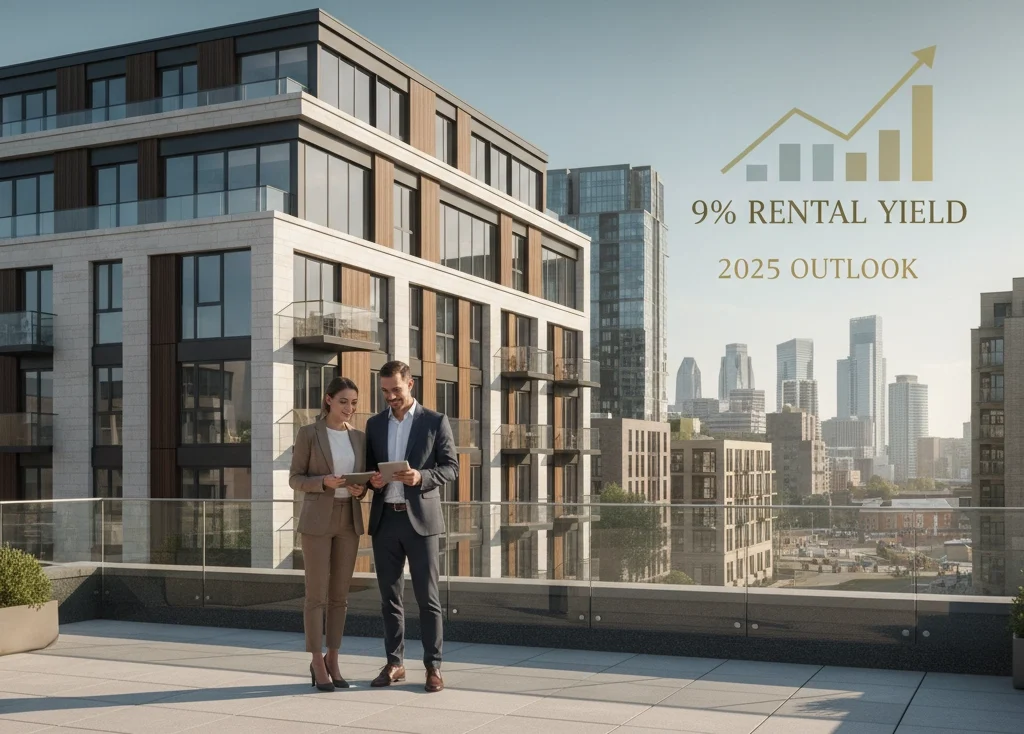You’ve spotted a property at auction promising a 9% rental yield, and your inner investor is doing backflips. The question is, are 9% Rental Yields Too Good to Be True? Here’s What Property Investors Need to Know in 2025. Before you get too excited, let’s talk reality. In today’s UK property market, 9% yields aren’t impossible, but they’re definitely not straightforward. If you’re wondering whether these yields are too good to be true and what property investors need to know in 2025, read on for insights. So, are 9% rental yields too good to be true? Here’s what property investors need to know in 2025 to make informed decisions.
How Rental Yields Actually Work
First things first: let’s make sure we’re all speaking the same language. Rental yield is simply your annual rental income divided by the property’s purchase price, multiplied by 100.
For example:
- Property cost: £100,000
- Annual rent: £9,000
- Yield: 9%
Sounds simple, right? But here’s where it gets tricky. That’s your gross yield: it doesn’t account for void periods, maintenance, management fees, insurance, or any of the other costs that eat into your returns while exploring whether 9% Rental Yields are too good to be true in 2025.
Your net yield is what matters for real-world planning. After all expenses, that shiny 9% gross yield might shrink to 6-7% net. Still decent, but not quite as spectacular.

Where You’ll Find 9% Yields in the UK
Let’s be honest about geography. You’re not finding 9% yields in central London or Bath. These higher returns typically show up in:
Northern England: Cities like Blackpool, Stoke-on-Trent, and parts of Liverpool have historically offered higher yields due to lower property prices.
Former Industrial Towns: Areas that haven’t fully recovered from industrial decline often provide higher yields but come with increased risks around tenant demand and property appreciation. Therefore, Are 9% Rental Yields Too Good to Be True? Here’s What Property Investors Need to Know in 2025 when targeting these regions.
Student Areas: University towns can offer strong yields, but they’re seasonal and require specialized management.
Commercial-to-Residential Conversions: Properties that have been converted from offices or other commercial uses sometimes offer attractive yields, especially when bought at auction.
The pattern? Higher yields usually mean lower capital growth potential. It’s the classic property investment trade-off. Naturally, this brings us to consider if high yields are too good to be true in the context of 2025.
Red Flags That Scream “Too Good to Be True”
Not all 9% yields are created equal. Here’s what should make you pause:
Declining Population Areas: If an area is losing residents year-on-year, that yield might be high because nobody wants to live there long-term. In 2025, Are 9% Rental Yields Too Good to Be True? Here’s What Property Investors Need to Know.
Single Industry Dependency: Towns that rely heavily on one employer or industry are risky. When that industry struggles, your tenant pool evaporates.
Massive Maintenance Backlogs: Some auction properties offer high theoretical yields because they need £20,000+ in immediate repairs. Factor these costs in, and your yield plummets.
Unrealistic Rent Estimates: Always check actual rental prices on Rightmove and SpareRoom for similar properties in the area. If the yield calculation uses inflated rent figures, you’re heading for disappointment.
Poor Transport Links: Properties with limited public transport connections struggle to attract and retain tenants, especially post-COVID as hybrid working becomes the norm.
Regional Reality Check for 2025
The UK property market isn’t uniform, and neither are rental yields. Here’s what different regions typically offer:
London: 3-5% yields are normal. Higher yields in outer boroughs like Barking & Dagenham, but even these rarely hit 9% after costs.
Southeast: 4-6% yields. Commuter towns can offer better returns than their proximity to London might suggest.
Northwest: This is where you’ll find some legitimate 8-9% opportunities, particularly in Manchester’s suburbs and regeneration areas.
Northeast: Higher yields available, but tenant demand can be patchy outside major cities like Newcastle.
Wales: Cardiff and Swansea suburbs can offer strong yields, with some areas genuinely hitting 8-9%.
Scotland: Glasgow and Edinburgh outskirts offer decent yields, though Edinburgh’s new short-term let restrictions have shaken up the market.

The Auction Advantage (and Risks)
In 2025, Are 9% Rental Yields Too Good to Be True? Here's What Property Investors Need to Know at auctions. Auction properties can legitimately offer higher yields because you’re often buying below market value. Here’s why:
- Motivated sellers need quick sales
- Less competition than open market sales
- Probate sales where families want fast completion
- Repossession properties priced for quick disposal
But auction buying requires homework. You can’t arrange surveys, and you’re committed once that hammer falls. The properties offering 9% yields at auction often need work: sometimes substantial work.
Making Sensible Investment Decisions
If you’re considering a property promising 9% yields, run through this checklist:
Local Market Research: Spend time in the area. Check local amenities, transport links, and employment opportunities. Would you want to live there?
Rental Demand: Contact three local letting agents. What’s the realistic rental price? How long do properties typically stay vacant?
Hidden Costs: Budget for refurbishment, ongoing maintenance, void periods, and management fees. A good rule of thumb is to assume 20-30% of rental income goes on costs.
Exit Strategy: High-yield areas often have poor capital growth. Are you comfortable with that trade-off?
Competition Analysis: Look at similar properties on auction sites and completion databases. Are you paying a fair price?
The 2025 Market Context
Several factors make 2025 an interesting year for rental yields:
Interest Rate Stability: After years of volatility, rates are finding a new normal, making investment calculations more predictable.
Build-to-Rent Competition: Large-scale rental developments are affecting yields in city centres, pushing investors toward suburbs and secondary cities.
Regulatory Changes: New energy efficiency requirements and licensing schemes are increasing costs but potentially reducing competition from amateur landlords.
Post-COVID Migration: People are still relocating from expensive areas to cheaper regions, creating new rental hotspots.

Practical Tips for First-Time Investors
If you’re new to property investment and attracted by high-yield promises:
Start Local: Invest in areas you know and can easily visit for viewings and property management.
Budget Conservatively: If a property promises 9% gross yield, plan for 6-7% net after all costs.
Build Relationships: Get to know local estate agents, letting agents, and tradespeople. Property investment is a people business.
Consider Property Management: Unless you live nearby and enjoy DIY, factor in management costs from day one.
Plan for Voids: Even good properties have vacancy periods. Budget for 10-15% annual void allowance.
When 9% Yields Are Worth It
Despite the risks, some 9% yield opportunities are genuine winners:
- Regeneration areas where significant investment is planned
- University towns with growing student populations
- Properties below market value that you can add value to through refurbishment
- Areas with new transport links (think Elizabeth Line impact zones)
- Properties with development potential for conversion or extension
The key is distinguishing between high yields due to opportunity and high yields due to risk.
The Bottom Line
Are 9% rental yields too good to be true? Not necessarily: but they’re rarely straightforward. In 2025’s UK property market, legitimate 9% gross yields exist, particularly through auction purchases in northern England and Wales. But Are 9% Rental Yields Too Good to Be True? Here’s What Property Investors Need to Know in 2025.
The real question isn’t whether these yields are achievable, but whether they fit your investment strategy. If you want passive income with minimal hassle, stick to lower-yield, higher-quality properties in stable areas. If you’re willing to be hands-on and accept higher risk for higher returns, some 9% yield opportunities could work well.
Remember: property investment success isn’t just about the highest yield: it’s about sustainable, long-term returns that let you sleep well at night.
Before you raise that bidding paddle at your next Palace Auctions viewing, make sure you’ve done the math on both the opportunities and the risks. The best property investors aren’t the ones chasing the highest yields: they’re the ones who understand exactly what they’re buying and why.
…


